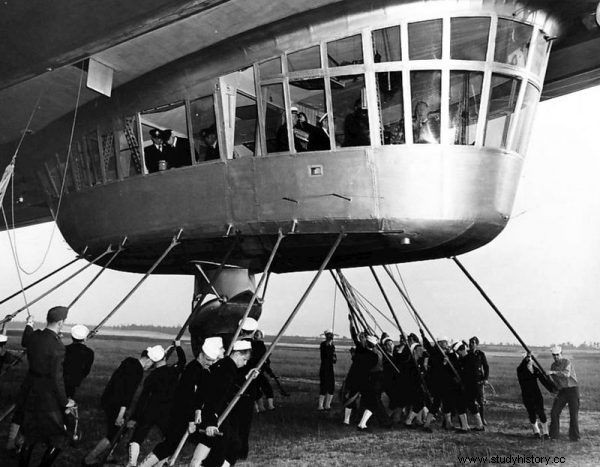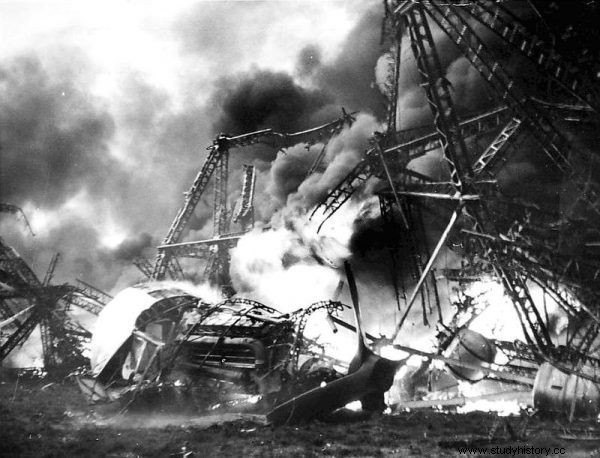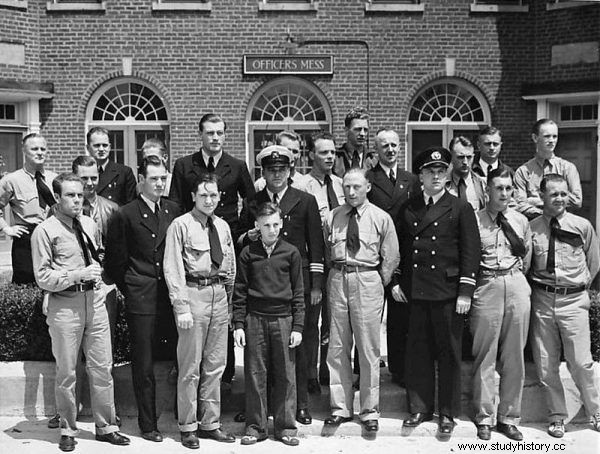Reporters couldn't find words when the mighty Hindenburg suddenly burst into flames on landing. After this catastrophe, the use of airships was discontinued for many years ... How did this tragic accident come about?
It was 1937, and Hindenburg - named after a former president of the Third Reich - was just opening a new season of its intercontinental travels. Viewed from below, it seemed indestructible, dominated by its massive silhouette, while moving silently and gracefully.

Hindenburg in flames
The same aircraft appeared a year earlier at the opening ceremony of the Games in Berlin. He managed to prove his abilities, flying over 190,000 miles in the first year of use and crossing the Atlantic Ocean seventeen times. This time, however, the flight ended very badly…
Time of the flying ships
Although it seems improbable in retrospect, the airships were high hopes not only in the transport industry. These huge machines took part in the First World War - the Germans used them as long-distance bombers. The well-known LZ-104 model, measuring as much as 226.5 meters in length, could carry over a ton of bombs; he also carried four machine guns on board.
These vehicles, popularly called zeppelins after the designer, Ferdinan von Zeppelin, were built of duralumin and… animal intestines! They have proven to be excellent for creating airtight coatings capable of retaining a carrier gas. The guts of approximately 250,000 cows were required for one ship.
It seems strange that the structure made of easy-to-pierce material was simply not shot through. Here the greatest advantage of zeppelins on the battlefield was revealed:the flight altitude. The Allies had fighters capable of climbing up to 3.5 kilometers, while airships could reach up to 7 kilometers! Moreover, if someone had already managed to hit the shells of the giant bomber, they did not ignite - at such high altitudes there was simply no oxygen!

First Hindenburg landing in the US.
Attempts to use fragmentation artillery ammunition also failed. In the end, it was decided to equip the fighters with machine guns pointing upwards, but the tragic statistics (0 to 15 to the detriment of the fighters) quickly verified the idea as well. The only downed airship was taken by surprise in 1915 by Reginald Alexander John Warnerod, who tracked down the LZ-37 after bombing Calais overnight. The German machine was already damaged and was moving low, allowing the pilot of the Royal Navy Aviation Corps to fly over it and hit it from above.
The Allies achieved a spectacular victory only when John Pomeroy developed special missiles loaded with nitroglycerin, fired alternately with incendiary cartridges. This solution was to lead to the ignition of hydrogen in airships in conditions of low oxygen content in the air. On September 2, 1916, thanks to the new ammunition, it was possible to shoot down a German aircraft - Lieutenant William Lee Robinson sat at the controls of the fighter. It soon became clear that the zeppelins were no longer relevant on the battlefield.
Read more: Hitler wanted to bomb New York. The Germans did not have a bomber with such a large range…
A miracle of technology, the conqueror of the Atlantic - an explosive balloon
The Hindenburg's tragic May flight in 1937 seemed completely ordinary. The crossing over the ocean was smooth, perhaps ignoring the wind blowing in the opposite direction to the flight. In the early afternoon, after flying over New York, the airship approached its destination airport - Lakehurst base in New Jersey. There were 61 crew and 36 passengers on board. The problems started when landing. As Pathé News commentator later described:
As it approached Lakehurst, Hindenburg appeared to be a giant dominating the heavens. But soon turned out to be merely a toy in the mighty grip of fate. Fate seemed to set the stage for this terrible tragedy - the ship was moving gracefully towards doom.
The airship reeled in circles over Lakehurst, shedding more ballast than ever before, trying in vain to straighten the flight. When the ballast was thrown out again, nervous tension overwhelmed the viewers, because it was very unusual. […]

Hindenburg's remains after the crash.
Finally, the ropes are dropped. Filmed by Pathé News operator William Deeke [...], these scenes show the explosion of the ship. The people on board are jumping to save themselves from a blazing hell. The fall of Hindenburg, the airship destroyed in less than half a minute.
To the horror of the onlookers, the airship suddenly burst into flames. It took several tens of seconds (various reports say 32, 35 or 37 seconds) for the hydrogen held in the balloon to turn into a fireball, and the Hindenburg crashed to the ground. The army and the fire brigade went to help, but not all of them were saved ...
Great unknown
Soon only the charred skeleton remained of the massive structure. Miraculously, 62 people were saved, including 23 passengers. The injured were transferred to the nearby Lakewood Hospital, and then, whenever possible, to New York City, 60 miles away. Crew members who emerged from the crash without serious injuries were accommodated at the canteen of the Officers' Base at Lakehurst. An investigation began soon to find out the causes of the crash. On May 10, Universal Newsreel reported:
Thirteen-year-old Verner Franz, a deck combatant and youngest survivor, will soon face the Department of Transportation's advice [...] But experts believe that the exact causes of the worst air crash will never come out to light. A question mark will hang over the Hindenburg, which we will never forget.
There are several hypotheses about the course of the tragedy. As you can guess, there were also conspiracy theories about sabotage among them. Hugo Eckner, manager of the Luftschiffbau Zeppelin, suggested that Hindenburg may have been shot down by a sniper using incendiary ammunition. Earlier, Eckner was to receive threatening letters. As soon as he found out about the catastrophe, he went to Berlin to gather more information. He learned that the airship did not "explode" as presented to him at the beginning, and "burned down". This diverted the speculation in a different direction:the spark from the static voltage that ignited the leaking gas may have been responsible for the catastrophe.
Read more:In this plane crash, almost the entire royal family died, which led to the fall of the dynasty ...
What beat Hindenburg?
Other experts were not convinced by Eckner's explanations. In the opinion of Max Pruss, captain of Hindenburg, the cause must have been sabotage. After all, airships had been traveled many times before, which even flew through storms and left them unscathed. Flights in huge aircrafts were considered very safe. The commandant of the Lakehurst base, Charles Rosendahl, even wrote a book elaborating on the possible reasons for the sabotage ("What about the Airship?", 1938).

The Hindenburg crew survived the crash.
The assumptions concerned mainly Joseph Späh - a German acrobat who was said to have acted suspiciously - and Erich Spehl, a foreman. Spehl was associated with a girl with anti-Nazi beliefs, knew about photography (which, according to conspiracy theorists, was equal to knowing light bulbs, and therefore possible detonators) and had access to the platform where the ignition happened. Moreover, the investigating service found traces of possible fuse remains near the fourth gas tank where Spehl! However, no hard evidence was discovered and Spehl himself was killed in the fire.
The sabotage theories were finally rejected (including another claiming that Hitler himself had ordered the destruction of the ship in order to wipe Eckner's nose). Meanwhile, more suggestions have joined the static discharge. According to one, Hindenburg was struck by lightning, according to another, the ignition caused an engine failure. However, it is not even known what was the first fuel for the fire:was it just hydrogen, somehow mixed with oxygen, or was it the paint on the balloon?
In any case, the statement by a Universal Newsreel reporter remains valid:it is not known what the actual causes of the crash were - and we will probably never know. "It represented the latest attempt to conquer the Atlantic by air," said the journalist further in the material. - “Tragedy will not stop progress. Knowledge will emerge from the ashes, and from fate the lesson will emerge that will lead to greater and better ways to conquer the air. That way, the tragic dead will not be gone in vain. ”
Bibliography:
- 1937-05-10 Special Release - Zeppelin Explodes Scores Dead . Universal Newsreel, 10 May 1937 (accessed 9/30/2020).
- Hoehling, A., A, Who Destroyed The Hindenburg? Boston, Little, Brown and Company.
- Tragedy of the Hindenburg, British Pathé, Pathé News, 1937 (access:30/09/2020).
